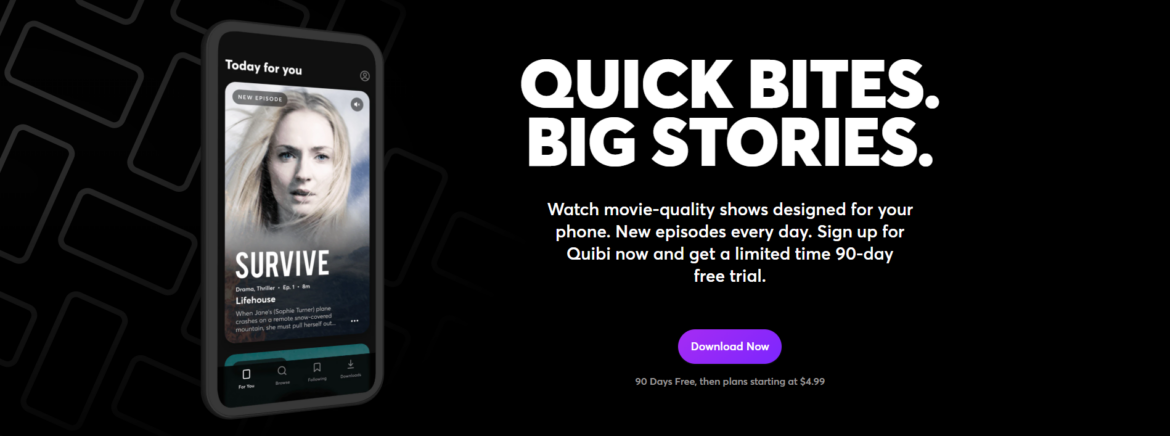Quibi is done.
- 75% of you are thinking “what’s Quibi?”
- 24% are wondering “so what?”
- 1% are remembering “I downloaded that app like 2 months ago but then I got really into Lovecraft Country.”
If you never heard of Quibi before, here’s a quick explanation from Reviews.org on YouTube.
Short content designed for mobile devices to be consumed in the flow of your typical day. Why does that sound so familiar? I’ll come back to that.
So what went wrong with Quibi? Why did it fail so quickly? Shouldn’t $1.75 BILLION in investment buy you more than six months of existence? Co-founder Jeffrey Katzenberg says “the idea itself wasn’t strong enough to justify a standalone streaming service or because of our timing.” Clearly, the pandemic created immediate and unexpected hurdles for the mobile-first entertainment service. Quibi (Quick Bite) was designed to be watched on the go. Unfortunately, when it launched in April 2020, most of the global population was in the middle of a lockdown.
But did the pandemic really take down Quibi by itself? 70% of smartphone owners worldwide have reported an increase in device usage as a result of the pandemic despite reductions in travel and work commutes. Streaming video surged 75% Q/Q in the US in June to 142.5 billion minutes. Streaming content like Lovecraft Country, Tiger King, Ted Lasso, and Enola Holmes became hits. People are still using their mobile devices, even at home. They are still watching plenty of video. There’s plenty of interest in new content. People just didn’t watch Quibi.
Quibi is one of the first high profile casualties of the streaming age. It will be studied for years as business, technology and entertainment analysts try to figure out what went wrong and what we can learn from it. It may even join the “what really happened” case study collection alongside Pets.com, Blockbuster and Kodak. But there’s also a lesson here for L&D pros.
The Quibi story is a cautionary tale for modern workplace learning, specifically the microlearning concept. Both lean into the idea of providing quick, meaningful bites that fit into people’s busy days. There’s a constant competition for what little free time we have available, especially moments that occur at inconvenient, unpredictable or hard-to-access times, such as waiting in line for coffee, riding on the bus or waiting for the next sales meeting. This is where Quibi and microlearning are supposed to fit in. Of course, Quibi wants to keep you watching while microlearning should be designed to get you in/out as fast as possible.
Quibi didn’t work. What does that mean for microlearning?
Here are five things L&D can learn from Quibi.
People won’t use it if they don’t get it.
How well did you understand Quibi? Very few people I’ve spoken with heard about it at all. I only learned about it pre-launch because I listen to The Vergecast. But I knew a lot about Disney+, HBO Max and Apple TV+ before they became available during the past year. Maybe I’m not in the Quibi demographic. Maybe they advertised on cable television, which I don’t have. Regardless, something went wrong with the marketing. People didn’t seem to know about the service. Beyond that, people didn’t know why they should care about 10-minute video bites (and therefore make the effort to download and pay for the service). It’s simple: if people aren’t aware, they can’t subscribe.
Microlearning Lesson: People won’t do it just because it’s shorter and designed to fit into the flow of work. Remember – workplace training, especially digital content, has been a less-than-stellar experience for many employees for a long time. L&D has to get the word out and communicate a clear microlearning value proposition. Make sure employees know what is available and why its worth their time and effort. Provide a clear answer to the question “how will this help me do my job better?”
Utility always wins.
Quibi provided “movie-quality shows designed for your phone.” Their Emmy-winning “#FreeRayshawn” was produced by Antoine Fuqua, starred Lawrence Fishburne and had a $1 million budget per episode (total of 15 10-minute episodes in the series). That’s some heavy production value. But Quibi was up against established content services like YouTube and TikTok. Most of their user-generated content has lower production values. But it also has three key elements that Quibi content was missing.
- It’s creative. Online creators have spent years stretching and evolving the format. They’ve leaned into their production constraints to do some really neat stuff that doesn’t look anything like standard TV or streaming programs.
- It’s fast. YouTubers and TikTokers are constantly building content. Some publish weekly. Some daily. Some multiple times every day. They can respond immediately to new information and trends. They don’t have to wait for budget approval or casting processes. They just create, share, repeat.
- It’s free. Why pay for 10-minute videos on my phone when I already have fun spending 45 minutes per day on TikTok for free?
Microlearning Lesson: It’s hard to keep up with workplace change (especially right now). Traditional learning tactics, which require people to step away from their work for lengthy periods, only add to this challenge. Microlearning can help solve this problem, but only if the content is focused on meaningful knowledge/skill and delivered in the moment of need. This means lengthy course development processes must be replaced with rapid problem-solving sprints. L&D must favor utility over form. Content doesn’t have to be pretty to help people do their jobs safely and productively. It just has to get the message across consistently, quickly and accurately.
Ubiquity is better than mobility.
Quibi could only be viewed on a mobile device. No TVs. No game consoles. Just phones and tablets. Why? I get that “TV on-the-go” was the core concept. But why can’t I watch the next 10-minute episode of the show that I really like on my TV when I happen to be at home? I want to access content whenever and wherever I am. I shouldn’t be restricted by device nowadays, especially for 10-minute viewing periods (as opposed to 60-second TikToks).
Microlearning Lesson: Don’t make assumptions about device preferences. Mobile devices do enable right-time, right-place content access for deskless employees. They’re proven to increase learning engagement. However, 76% of adults in advanced economies own a smartphone. That’s not everyone. Also, not every employee may prefer to use their phone for job training. Also also, mobile devices are not the right-fit access point for every possible learning solution. L&D must design within these realities and build ubiquitous solutions that leverage the full range of potential workplace technologies, from personal devices and laptops to point of sale systems and internet-connected deli scales. Match the message to the solution to the access point.
People have time, but they also have options.
People are busy, but they still have time. 2,375,000,000 hours of video was streamed in the US from April to June. Viewers found that time somewhere. Of course, this year is very different when it comes to how we’re spending our free time. However, over 1.3 billion hours of video was streamed in Q2 of 2019 too. People have the time. They also have plenty of options. Netflix. YouTube. HBO Max. Prime Video. Apple TV+. Hulu. Disney+. There are over 200 streaming services. It takes the right combination of product, price and promotion to get access to that time. Quibi missed.
Microlearning Lesson: People are extremely busy at work. But they also have free time … and options on how to use it. Microlearning allows L&D to deliver solutions that fit into this available time, without requiring employees to step away from their workspace (mentally or physically) for extended periods. However, you must also find the right balance. Employees must be aware of microlearning opportunities. They must understand the value they provide. And they must be easily accessed. Only then will they pay for your services with their time, attention and effort.
New tech can’t overcome a traditional mindset
Quibi entering the streaming war with a clever idea, some new, short-form content and a decent app. Netflix, Disney+, Hulu, Peacock and HBO Max’s battle plans are grounded in their extensive catalogues of proven content … plus some hit and miss new stuff. Quibi applied a traditional media mindset during a revolution. They focused on where people use their phones and failed to acknowledge how people engage with media today. Maybe the content wasn’t very good. But they also didn’t have The Office or Friends to back it up.
Microlearning Lesson: Traditional, long-form courses broken down into shorter segments doesn’t work. A microlearning approach begins with a mindset shift, not content design. L&D must explore performance challenges from new angles and find right-fit solutions while considering every ecosystem option. However, when it comes to learning, you have to hit the mark. The last 20 years have proven that giant, one-size-fits-all content catalogues can’t be used as workplace learning crutches.
L&D pros often look to the consumer marketplace for inspiration on how to improve our practices. This shouldn’t be limited to the ideas that worked out great. While we may never know exactly what went wrong (Jack from The Guardian has several opinions), we can learn from the failure of Quibi. Making content shorter doesn’t automatically make it better – in entertainment or learning. If you want people to pay attention and spend their limited time (and money) on your products, you must provide a clear value proposition. In entertainment, you have to tell a good story and distract the viewer from everyday reality. In learning, we have to help people do their jobs better.



